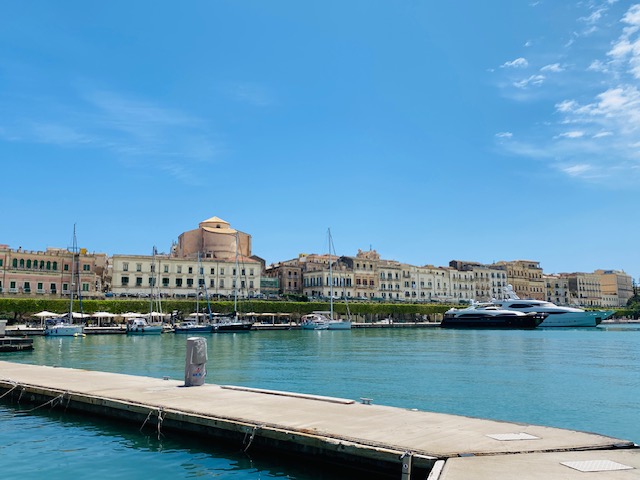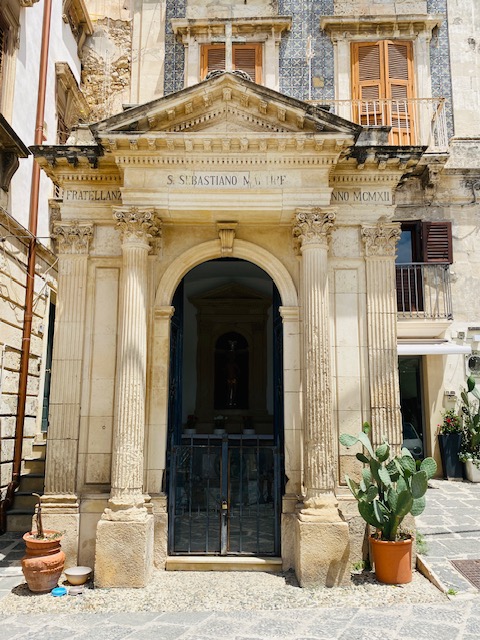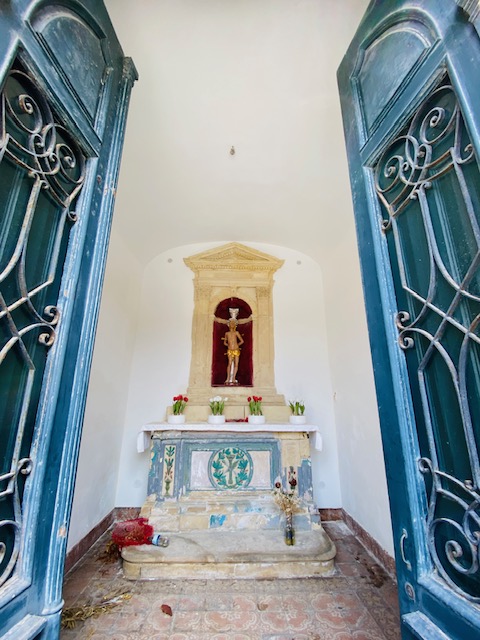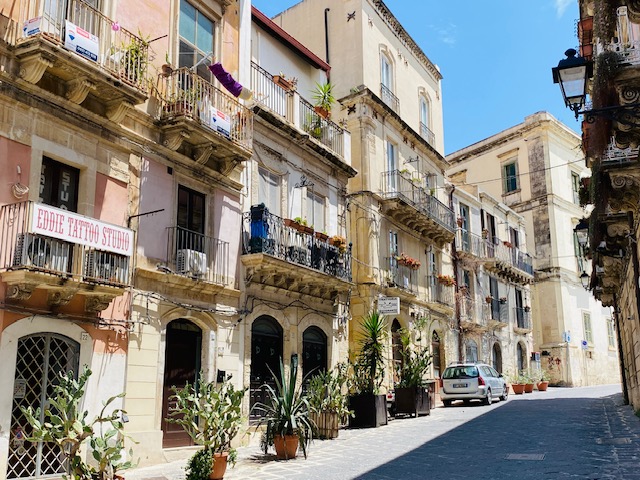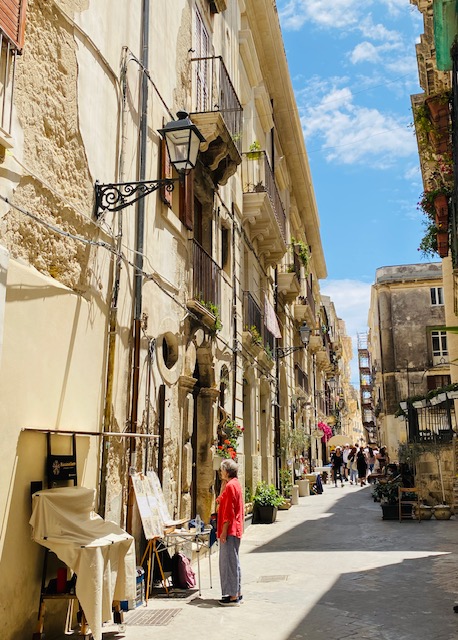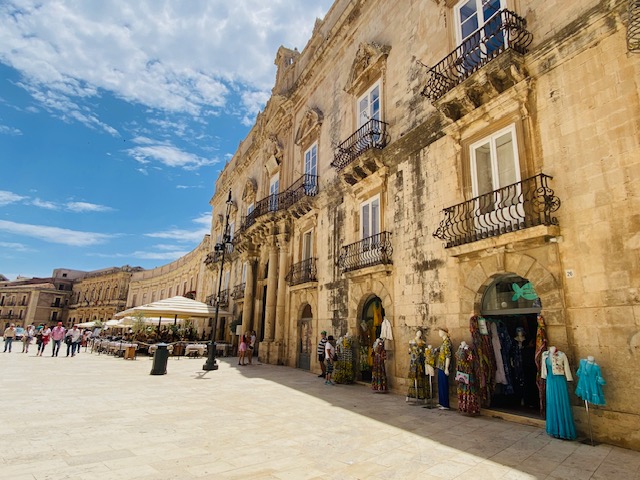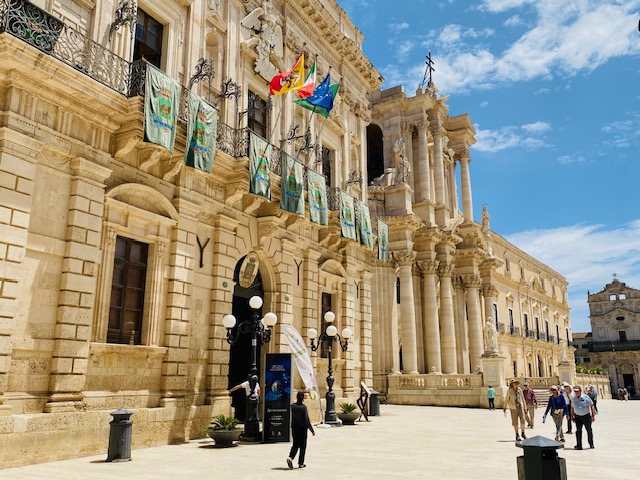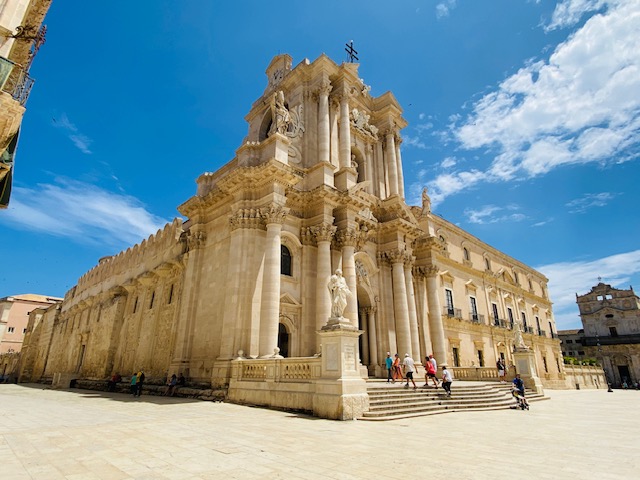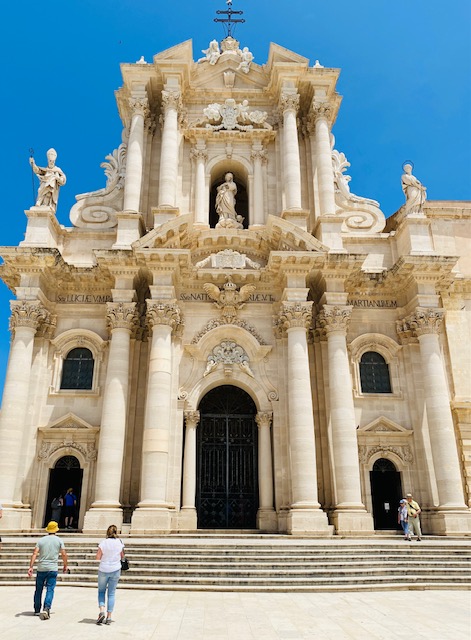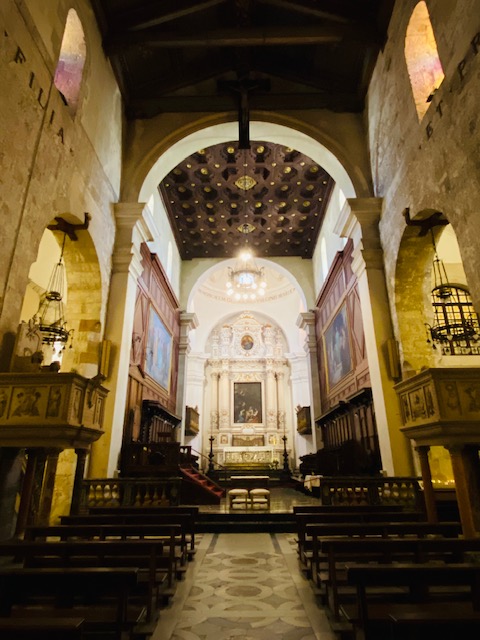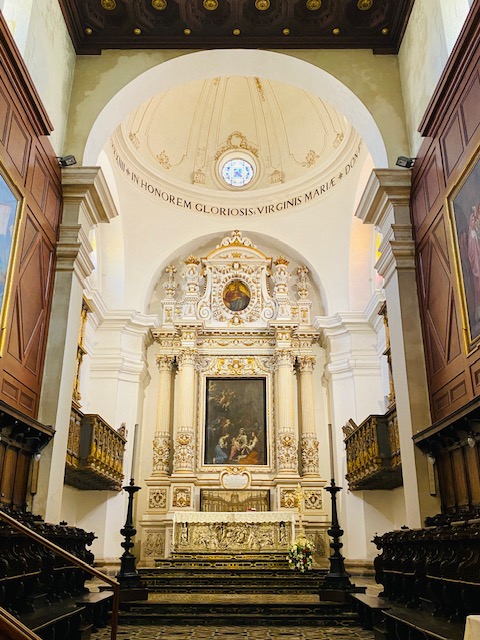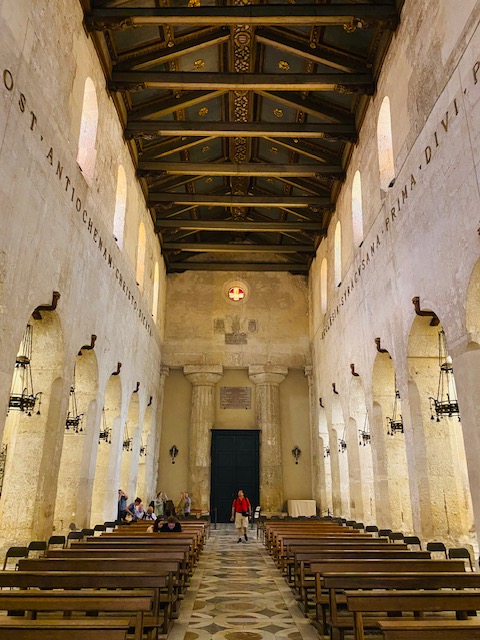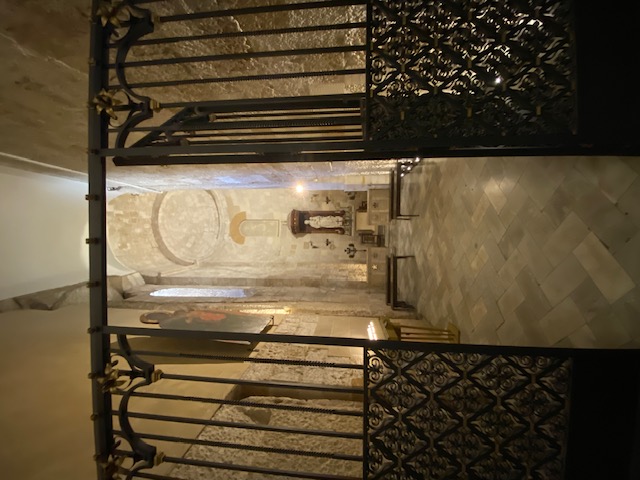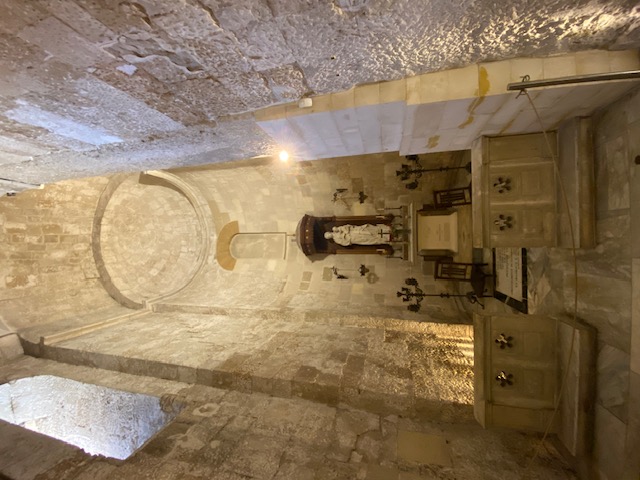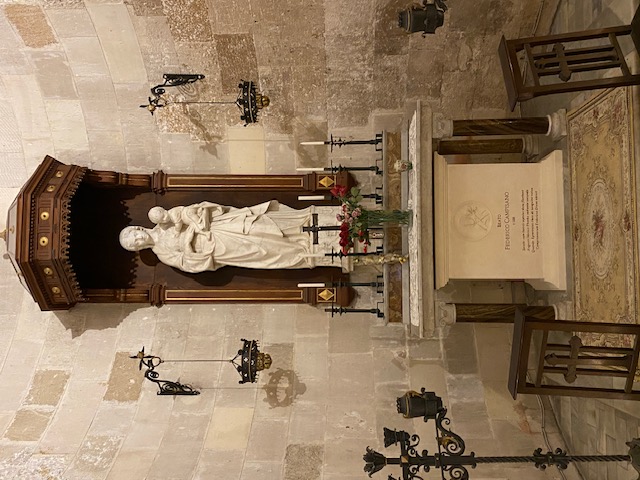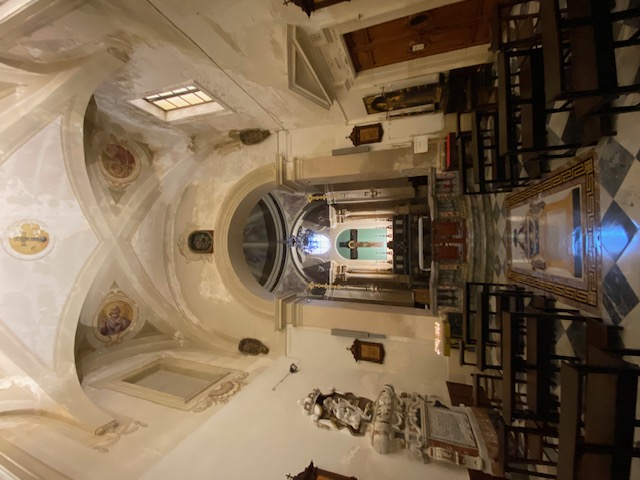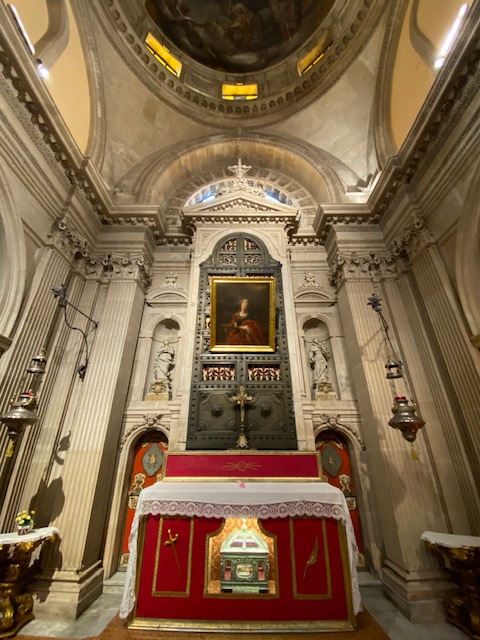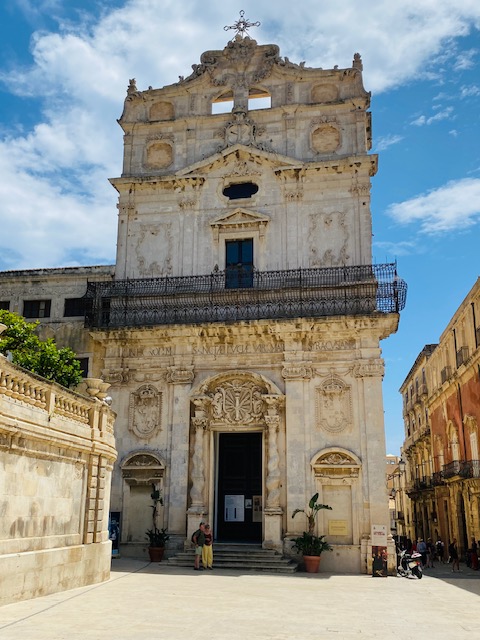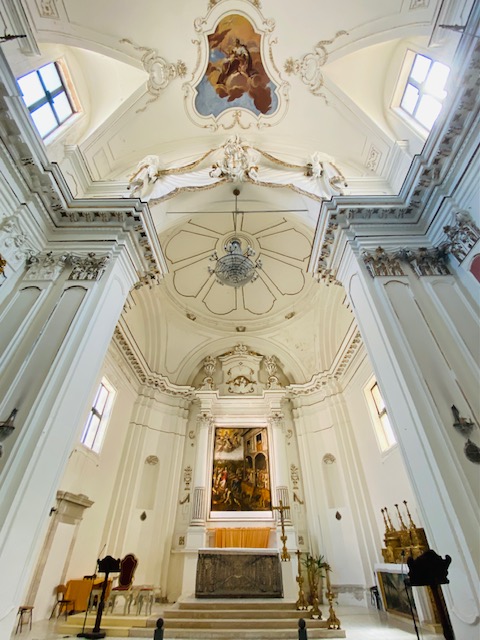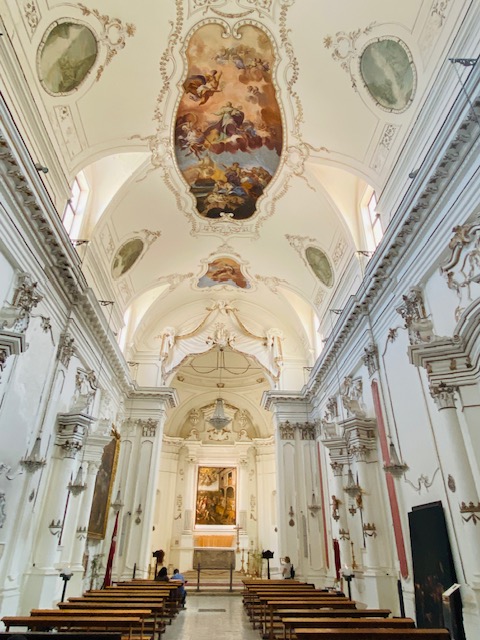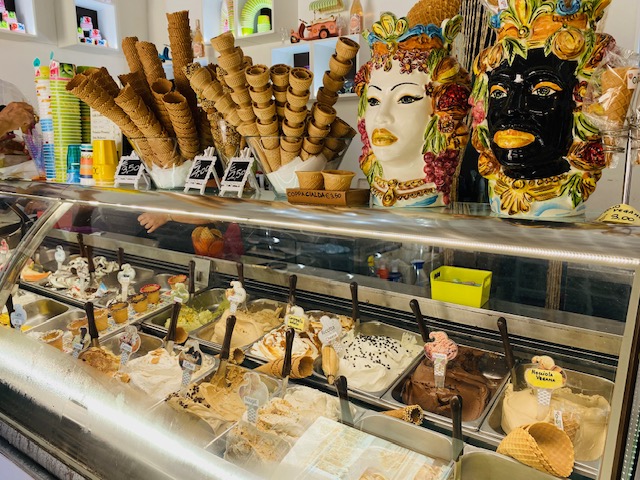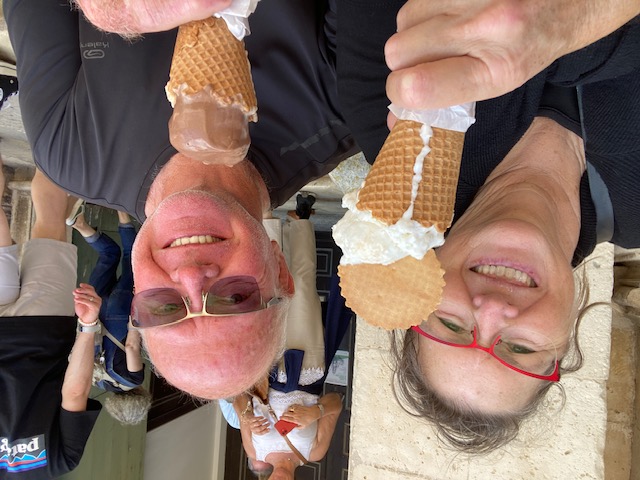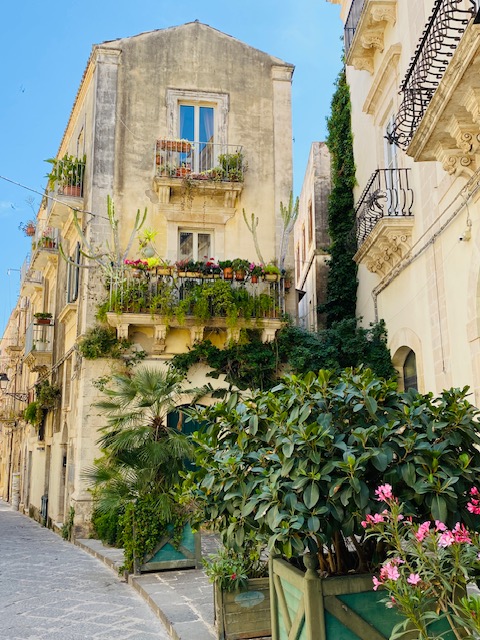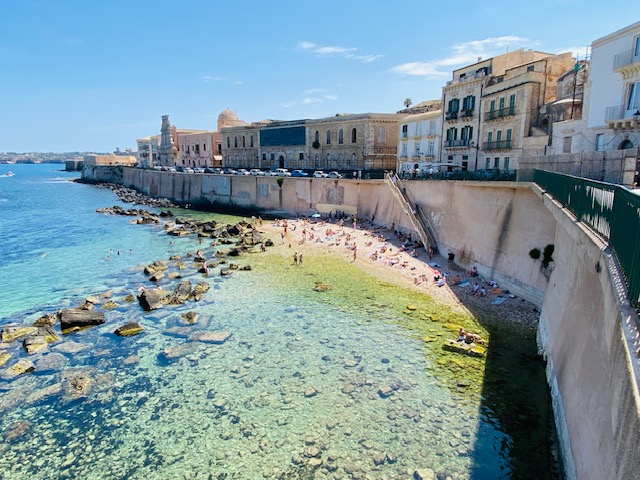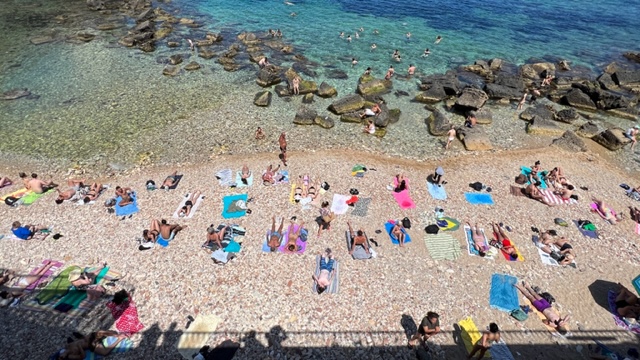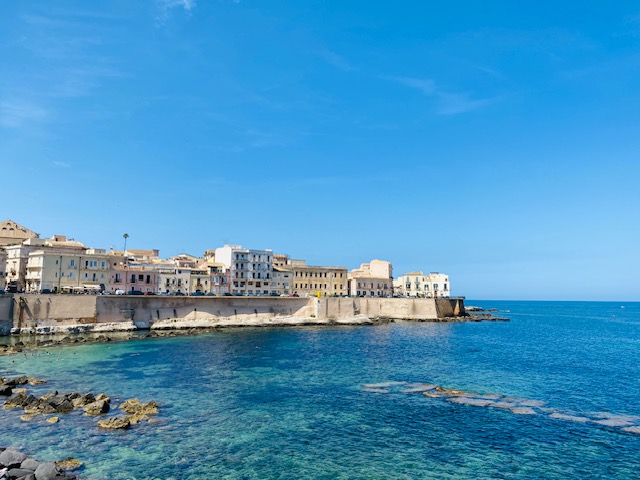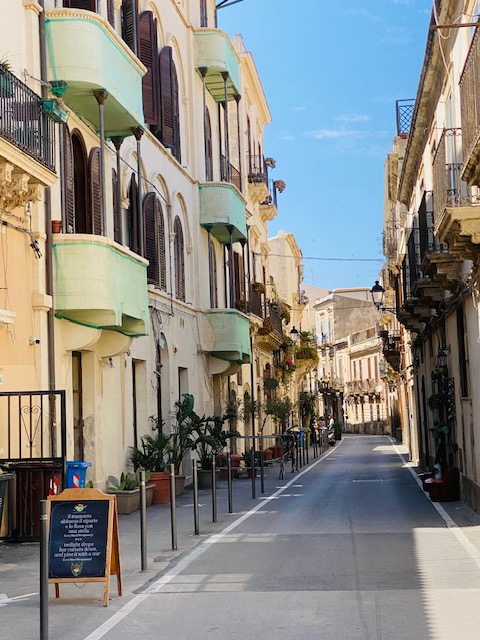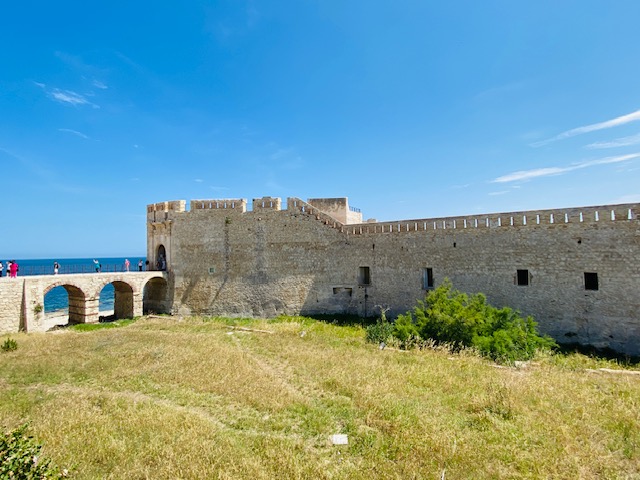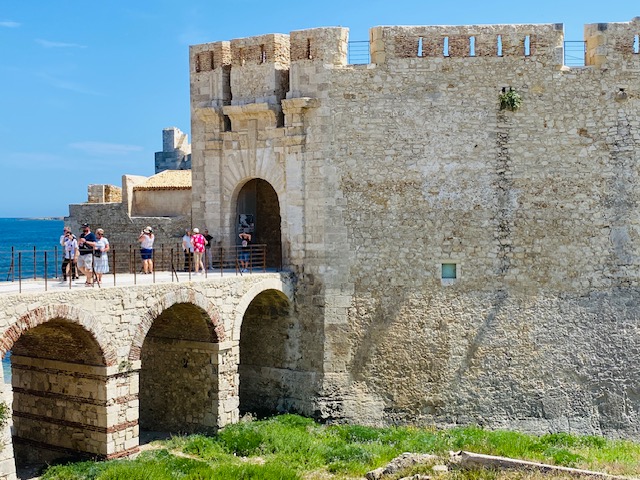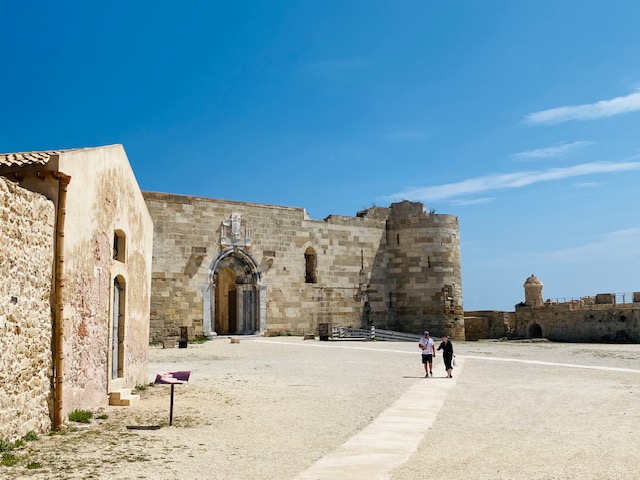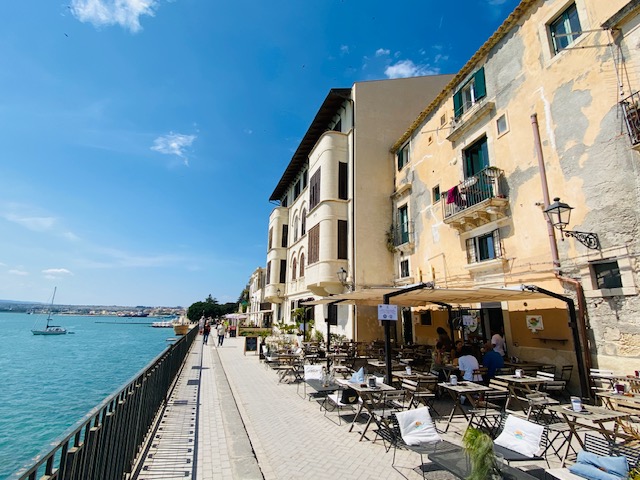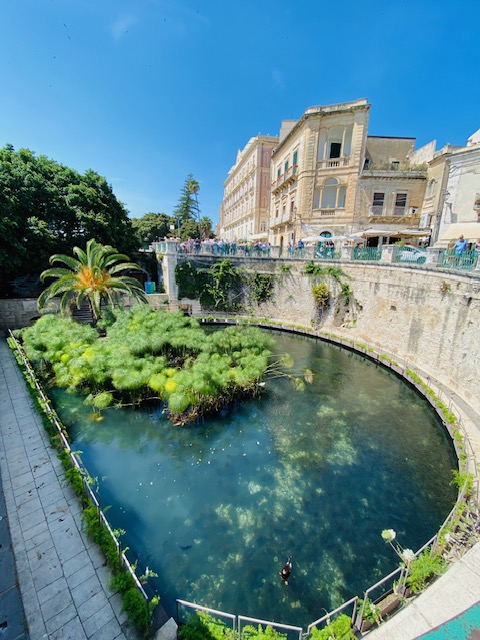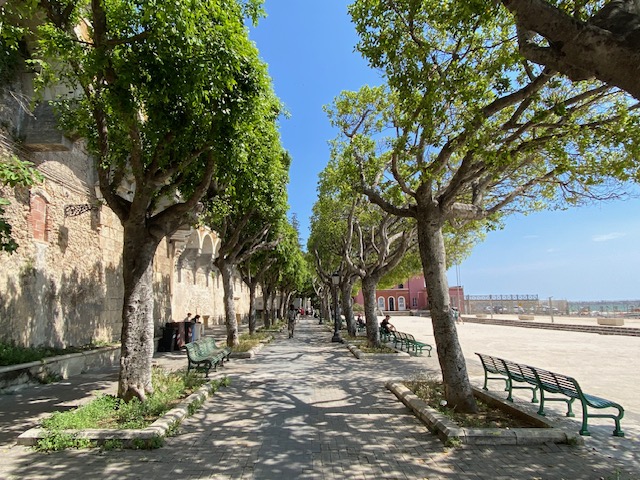Then it was time to head ashore and explore Syracuse, specifically the historic areas on Ortygia Island, but not before we found a delightful little café on one of the back streets, Caffetteria Mastroianni, to enjoy a morning coffee and a baked delight. While Roy had a chocolate filled croissant, Elaine has no idea of what she actually ate; definitely an interesting combination of sweet and savoury.
Fuelled on caffeine and sugar we set off in the direction of the basilica and what a fabulous experience awaited us.
Passing some beautiful buildings along the way as we meandered through the narrow streets and passing a tiny chapel, we came upon “La Piazza Duomo”, the city square, the heart of the historic area, surrounded by magnificent buildings and, in particular, “Duomo di Siracusa” (Cathedral of Syacuse). Having had the opportunity to see amazing architecture and craftsmanship all over the world during our circumnavigation, this cathedral rivalled the best.
The original core of the cathedral, built of limestone and covered with plaster, was constructed in the 5th Century BC as a Greek doric temple, with six columns on the short sides and fourteen on the long sides, dedicated to the goddess, Athena, and, as such, is a UNESCO World Heritage Site.
However, an archeological excavation in 1907-1910 showed that the Greek temple had been built on even older foundations and uncovered a wealth of archaic and pre-Hellenic artefacts, all housed in the Archeological Museum of Syracuse.
The present cathedral was constructed in the 7th Century, incorporating the doric columns of the original temple, which we could see inside and out.
The interior of the church had numerous naves and chapels. There was one, however, where we were not permitted to take photographs, but was exquisite, including the well preserved frescoes on the domed ceilings. One couldn’t escape the ornate opulence and certainly made us wonder about the wealth required to construct such a structure, contrasted against a standard of living the ordinary citizens, or indeed the worshippers, may have had.
Adjacent to the cathedral, at the far southern end of the piazza, was “Chiesa di Santa Lucia alla Badia”, another Roman Catholic church, although now deconsecrated, and an adjoining former monastery. It was another magnificent structure with a beautiful baroque-style interior.
After taking the time to appreciate its interior as well, we stopped for an ice-cream from Gelati Bianca before continuing our wanderings through the back streets and popping out on the waterfront on the eastern side of the city, where we were surprised to find bathers enjoying “Spiaggia Di Cala Rossa” (Cala Rossa Beach); the water must have been freezing!
From there we continued along the waterfront towards “Castello Maniace” (Maniace Castle), situated at the far point of the Ortygia Island promontory, together with the citadel. Having sailed passed it yesterday, it was interesting to see the structure up close, constructed between 1232 and 1240 by the Emperor Frederick II, King of Sicily, but bears the name of George Maniakes, the Byzantine general who besieged and took the city in 1038. Research revealed that King Peter III of Aragon resided here with his family in 1288 and from 1305 to 1536 it was used as a residence by numerous queens of Sicily.
Continuing our stroll along the waterfront on the inside of the bay, we stumbled upon “Fonte Arethusa” (the Fountain of Arethusa) or the Arethusa Spring, a natural spring on the island. According to Greek mythology, this freshwater fountain is the place where the nymph Arethusa, the patron figure of ancient Syracuse, returned to earth's surface after escaping from her undersea home in Arcadia. This fountain, the river Ciane, south of Syracuse, and the river Fiume Freddo in the province of Catania are the only places in Europe where papyrus grows.
This 2,700-year-old city, Syracuse, pronounced “sara’usa”, is the capital of the Italian province of the same name, with its rich Greek and Roman history, culture and architecture, as well as being the birthplace and home of the pre-eminent mathematician and engineer, Archimedes, a statue of whom stands near the marina and town harbour, provided us with another wonderful day of exploring, making all our efforts of hunkering down for bad weather, long motoring days and rolly anchorages to get here, worth the while.
Both relieved to have had a good night’s sleep in a very calm anchorage, without bouncing around all over the place in a terrible swell, after breakfast, Elaine relooked at our route options considering the very unpredictable and unpleasant weather patterns in this part of the world, while Roy did two diesel runs, having eventually found the fuel dock, one we would never consider taking Paw Paw onto.
Then it was time to head ashore and explore Syracuse, specifically the historic areas on Ortygia Island, but not before we found a delightful little café on one of the back streets, Caffetteria Mastroianni, to enjoy a morning coffee and a baked delight. While Roy had a chocolate filled croissant, Elaine has no idea of what she actually ate; definitely an interesting combination of sweet and savoury.
Fuelled on caffeine and sugar we set off in the direction of the basilica and what a fabulous experience awaited us.
Passing some beautiful buildings along the way as we meandered through the narrow streets and passing a tiny chapel, we came upon “La Piazza Duomo”, the city square, the heart of the historic area, surrounded by magnificent buildings and, in particular, “Duomo di Siracusa” (Cathedral of Syacuse). Having had the opportunity to see amazing architecture and craftsmanship all over the world during our circumnavigation, this cathedral rivalled the best.
The original core of the cathedral, built of limestone and covered with plaster, was constructed in the 5th Century BC as a Greek doric temple, with six columns on the short sides and fourteen on the long sides, dedicated to the goddess, Athena, and, as such, is a UNESCO World Heritage Site.
However, an archeological excavation in 1907-1910 showed that the Greek temple had been built on even older foundations and uncovered a wealth of archaic and pre-Hellenic artefacts, all housed in the Archeological Museum of Syracuse.
The present cathedral was constructed in the 7th Century, incorporating the doric columns of the original temple, which we could see inside and out.
The interior of the church had numerous naves and chapels. There was one, however, where we were not permitted to take photographs, but was exquisite, including the well preserved frescoes on the domed ceilings. One couldn’t escape the ornate opulence and certainly made us wonder about the wealth required to construct such a structure, contrasted against a standard of living the ordinary citizens, or indeed the worshippers, may have had.
Adjacent to the cathedral, at the far southern end of the piazza, was “Chiesa di Santa Lucia alla Badia”, another Roman Catholic church, although now deconsecrated, and an adjoining former monastery. It was another magnificent structure with a beautiful baroque-style interior.
After taking the time to appreciate its interior as well, we stopped for an ice-cream from Gelati Bianca before continuing our wanderings through the back streets and popping out on the waterfront on the eastern side of the city, where we were surprised to find bathers enjoying “Spiaggia Di Cala Rossa” (Cala Rossa Beach); the water must have been freezing!
From there we continued along the waterfront towards “Castello Maniace” (Maniace Castle), situated at the far point of the Ortygia Island promontory, together with the citadel. Having sailed passed it yesterday, it was interesting to see the structure up close, constructed between 1232 and 1240 by the Emperor Frederick II, King of Sicily, but bears the name of George Maniakes, the Byzantine general who besieged and took the city in 1038. Research revealed that King Peter III of Aragon resided here with his family in 1288 and from 1305 to 1536 it was used as a residence by numerous queens of Sicily.
Continuing our stroll along the waterfront on the inside of the bay, we stumbled upon “Fonte Arethusa” (the Fountain of Arethusa) or the Arethusa Spring, a natural spring on the island. According to Greek mythology, this freshwater fountain is the place where the nymph Arethusa, the patron figure of ancient Syracuse, returned to earth's surface after escaping from her undersea home in Arcadia. This fountain, the river Ciane, south of Syracuse, and the river Fiume Freddo in the province of Catania are the only places in Europe where papyrus grows.
This 2,700-year-old city, Syracuse, pronounced “sara’usa”, is the capital of the Italian province of the same name, with its rich Greek and Roman history, culture and architecture, as well as being the birthplace and home of the pre-eminent mathematician and engineer, Archimedes, a statue of whom stands near the marina and town harbour, provided us with another wonderful day of exploring, making all our efforts of hunkering down for bad weather, long motoring days and rolly anchorages to get here, worth the while.
